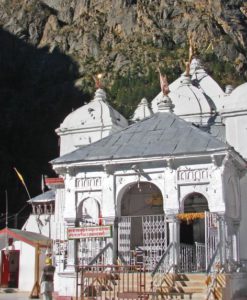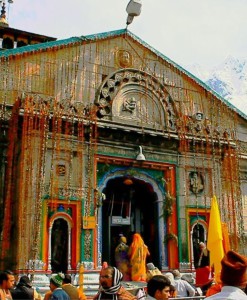No products in the cart.
Gangotri Temple is one of the Char Dhams in the Uttarkashi district of Uttarakhand, India. It is located at a height of 3048 meter and at a distance of 98 km from Uttarkashi. It is the highest and most important temple of the Goddess Ganga. “Gangotri” is Sanskrit word which means Ganga+Uttari i.e. Ganga flows in a northwesterly direction.
This 18th century temple made of white granite structure at the height of 20 ft attracts tremendous devotees to catch the holy glimpses of the divine stature of power- the holy goddess Ganges.
Gangotri Temple is 228 km from Yamunotri temple, another pilgrim place of Chota Char Dham Yatra. Uttarakashi is the gateway to Gangotri and there is no other way to reach Gangotri by road. Here road ends and trekking rout to Gaumukh starts.
Gaumukh glacier is the source of Bhagirathi River which is also known as Ganga River before the confluence with Alaknanda at Devprayag. The Glacier is situated 18kms from Gangotri. ‘Gau’ means Cow and ‘Mukh’ means face hence the combined meaning of Gaumukh is cow’s face. If you carefully observe the cave from where the water gushes out it will resemble as a cow’s face. Gaumukh is the second largest glacier of India, only after the Siachen glacier.
And, a natural submerged rock in the form of partial shivaling along the Gangotri Temple brings great significance to all where it is believed to be the same spot where Lord Shiva entangled the great waves of river Ganges in his matted locks.
Gangotri, Uttarakhand
According to the legend, King Sagar, after destroying the demons on earth, performed an Aswamedh Yagna inorder to declare his Supremacy. King’s 60,000 sons from Queen Sumati and one son Asamanjas from Queen Kesani were to accompany the Horse. Indra, Supreme ruler feared of the defeat of his supremacy if ‘Yagya’ succeeded, so took away the horse and tied it to the ashram of Sage Kapil,who was in deep meditation. The sons of the King came in search of the horse and found it near the meditating sage. Sixty Thousand angry sons of King Sagar stormed the ashram of sage Kapil. When he opened his eyes, the 60,000 sons were reduced to ashes except Asamanjas by the curse of sage Kapil. Bhagirath,the grandson of King sagar is believed to be meditated for 5500 years to please Goddess Ganga to cleanse the ashes of his ancestors and granting them Moksha.
As the legend goes, King Bhagirath used to worship Lord Shiva at the sacred stone, near which this 18th century temple is located. The slab on which King Bhagirath is believed to have meditated is called Bhagirathi Shila. Since it was due to the efforts of Bhagiratha that Ganga came down to earth, she spiritually became his daughter. Hence the river is also called by the name of Bhagirathi (Bhagiratha’s daughter).
Also Lord Shiva was very happy with King Bhagiratha’s penance and took Ganga in his matted hair before she came down to earth. This supposedly broke her pride of being a celestial river and instilled a sense of helping humanity in her. It was then negotiated that Goddess Uma or Parvati, Shiva’s wife, would have her daily bath in the Ganges and only then would she descend on the earth.
According to another legend, Pandavas performed the great ‘Deva Yagna’ here to atone the deaths of their kinsmen in the epic battle of Mahabharata.
Special Rituals performed in temple
Before performing the Puja rituals, a holy dip in the Ganga flowing nearby the temple is a must. The Pujari’s (priest) belong to Brahmin community from Mukhwa village. Ten of them are selected by rotation every year to perform all the functions covering the temple and they also perform the duties.
Info on the deity – Specific to the temple deity
The most sacred of all rivers is the Ganga. The Ganga symbolizes purity. It washes away all sins. It is compared to a mother goddess who presides through all the stages of life: from birth to death. The river is believed to have been born out of Vishnu’s big toe. It is said to flow through the skies (like the Milky Way).
Temple Daily Schedule
Morning: 6:15 am to 2:00 pm
Evening: 3:00 pm to 9:30 pm
Opening and Closing of the Temple
Like the Sister Shrine of Yamunotri, Gangotri opens every year on the day of “Akshaya-Tritiya”, which falls during last week of April or first week of May with formal Pooja of Gangaji. Gangotri Temple closes on the day of Diwali after performing closing rituals along with usual Pooja. During the rest of the period Gangotri Temple is covered with snow. The idol of the goddess is kept at Mukhba village, near Harsil during this period.
By Air
About 226 km away is the nearest domestic airport Jolly Grant airport in Dehradun which is well-connected to Delhi International airport. Taxis are available from Jolly Grant airport to Gangotri.
By Rail
Nearest railway station is Rishikesh, 250 km away, well-connected with other major stations. But it is a small station and Express trains don’t run through it. Plenty of buses and taxis are available for Gangotri from the station.
By Road
Two routes are available one starting from Haridwar and another from Dehradun. The first route is:
Haridwar-Rishikesh-Narendranagar-Tehri-DharasuBend-Uttarkashi-Bhatwari-Gangnani-Harsil-Gangotri.
And the second route follows:
Dehradun-Mussoorie-Chamba-Tehri-DharasuBend-Uttarkashi-Bhatwari-Gangnani-Harsil-Gangotri.
Buses and motors are available too from major destinations.






